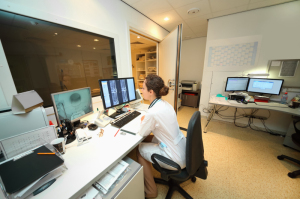by
Lauren Dubinsky, Senior Reporter | August 03, 2016

They can see what other doctors can't
Cancer imaging is expected to increase over the next decade, and radiologists will have to establish themselves as central members of the cancer team. An article recently published in the
American Journal of Roentgenology calls on radiologists to have a broader understanding of imaging-evident toxicity.
"Radiologists are in a unique position to be able to see the response a drug is causing, while simultaneously seeing the side effects it has on other organ systems," Dr. Stephanie A. Holler Howard of the radiology department at Dana Farber Cancer Institute in Boston, told HCB News.
Advances in cancer therapy are allowing many cancer patients to live longer with metastatic disease. Newer drugs, such as molecular targeted therapies and immune checkpoint inhibitors, have toxicity profiles that differ from those seen with traditional chemotherapies.



Ad Statistics
Times Displayed: 130299
Times Visited: 7399 MIT labs, experts in Multi-Vendor component level repair of: MRI Coils, RF amplifiers, Gradient Amplifiers Contrast Media Injectors. System repairs, sub-assembly repairs, component level repairs, refurbish/calibrate. info@mitlabsusa.com/+1 (305) 470-8013
In certain instances, toxicity can be an indication that the treatment is working, so a cancer care team might tolerate toxicity in low levels for the overall benefit of the patient. The radiologists have to understand the nuances of drug toxicity in order to help the cancer team decide the best plan of care, said Howard.
A team of radiologists and researchers led by Howard wrote the article titled, "A New Look at Toxicity in the Era of Precision Oncology: Imaging Findings, Their Relationship With Tumor Response, and Effect on Metastasectomy". Their goal is to help radiologists better understand imaging-evident toxicity.
Newer drugs often work for many tumor types and oncologists are starting to experiment with drug combinations more. But toxicity associated with combined drugs has been unpredictable and much more severe than when drugs are used in isolation.
"[Radiologists] are well suited to discuss the risk/benefit profiles of these drugs, and help oncologists and surgeons make decisions for optimal patient care," said Howard. "As patients live longer with advanced disease, the appropriate treatment decisions will likely not be clear cut."
She added that they should be a "vocal part of the treatment team," since they have the unique opportunity to see both the positive and negative impact of the drug throughout the body.

